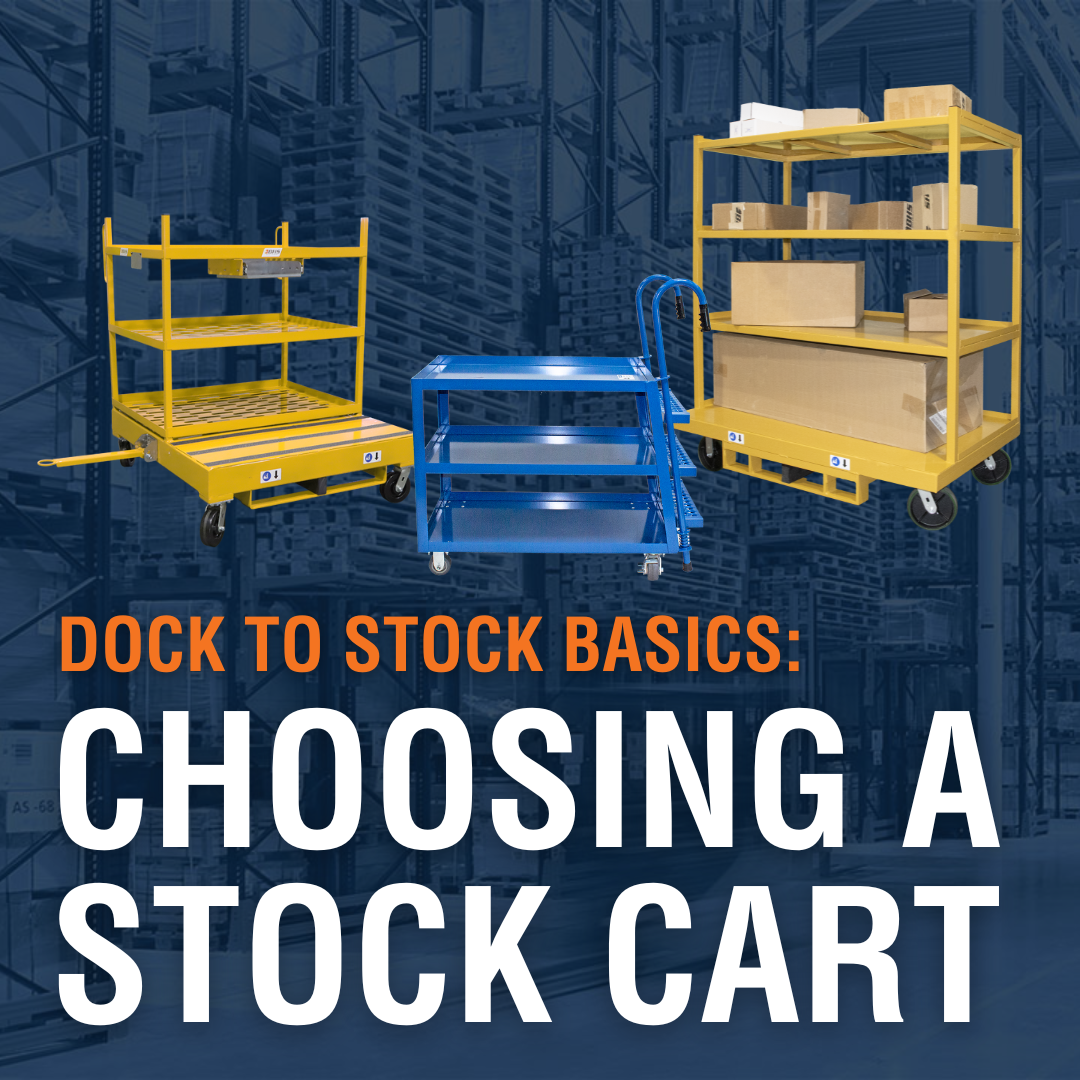We use cookies to make your experience better. To comply with the new e-Privacy directive, we need to ask for your consent to set the cookies. Learn more.
Dock to Stock Basics: Choosing a Stock Cart

In the warehousing industry, we spend a lot of time thinking about order picking.
Should we try zone, wave, or batch picking? Which is better, bigger Order Picking Carts or more nimble Stock Picking Carts? Is it possible to make order fulfillment safer and more efficient at once?
Good questions. But order picking isn’t the only process that might help us run safer, more productive distribution and fulfillment centers. It’s time we talked about an earlier step in the order’s journey, too: the dock to stock process
Here’s how this sometimes-overlooked metric might be the key to higher throughput at your distribution center — plus the features that make an ideal dock to stock cart
Dock to Stock as Process and Metric
So what is dock to stock in warehousing? Two things: A process and a key performance indicator (KPI
As a process, dock to stock describes how you receive, log, break down, and move an inbound shipment into pickable shelving units (or long-term storage). It’s the first stage of a product’s journey within your distribution center
As a metric, dock to stock (DTS) time measures the interval between a delivery’s arrival at the dock and its dispersal to your shelves. If your DTS cycle is taking too long, that could be a sign of inefficient processes or insufficient material handling equipment
Here are some rough benchmarks for what’s considered a “good” DTS time
- According to the Institute for Supply Management (ISM), the gold standard for DTS time is around eight to 10 hours.
- A third-party logistics provider may take as long as 48 hours for DTS, since their facilities serve many companies.
- For a midsize warehousing operation, the sweet spot for DTS is between 12 and 24 hours, says ISM.
Take the time to measure your DTS cycle. If shipments are taking days to make it to the shelf, odds are you can improve your operation
Industry publication Multichannel Merchant points to a few of the common causes of a slow dock to stock time. Your dock or staging area might not be big enough. It might be efficiently organized. You may have paperwork problems with your vendors. Or your putaway process itself may need an overhaul
Of course, you can’t perfect your dock to stock process without the right tools for the job. If your facility isn’t fully automated — and few are, with eight out of 10 warehouses remaining totally automation-free — that means you need the right stock cart for DTS
That’s where BHS, Inc. can help.
Choosing a Stock Cart for the Dock to Stock Process
The ideal stock cart for dock to stock putaway depends, of course, on what you’re putting away. If you operate a cross-docking facility, and never have to break down pallet loads, you need forklifts, not carts
But assuming your orders break down into cartons or pieces before heading to the shelves, a few features will improve your DTS operation regardless of the specifics of your materials. Look for these elements to choose the perfect stock cart for DTS tasks
- Optimized carrying capacity. The more you can carry on a stock cart, the fewer trips putaway staff will have to take — up to a point. Carts must not be too heavy for hand-pushing (unless you’re using tuggers and Industrial Trailers, but that’s a whole other topic). Look for large-area shelves and capacities of 1,000 pounds or more; even if you don’t fully load them, these high carrying limits suggest rugged construction. That brings us to our next point.
- Heavy duty materials. Plastic or aluminum stock carts are everywhere, but they don’t hold up to the rigors of a distribution center. Maintenance and replacement costs eventually drive operating prices up. Instead, look for welded steel carts built to last a lifetime.
- Versatility. Order Picking Carts from BHS, Inc. feature integrated fork pockets. The ability to pick them up with a lift truck or pallet jack supports way more use cases than manual operation alone, which can help when you get a particularly heavy shipment that needs to get on the shelves. Our Stock Picking Carts have step stools built into the push bars, opening high shelves to staff without additional equipment. Look for additional features that support your facility’s DTS needs.
- Customization. To really improve throughput, carts must match the materials they carry. Sometimes that requires custom features, such as angled shelves, enclosed sides, swing gates, or custom shelf tops.
At BHS, Inc., we offer custom engineering and in-house manufacturing to match any use case. That includes the materials you need to move from dock to stock — no matter what they may be.
To improve safety and throughput in your DTS process, choose from our collection of Industrial Carts, or contact our sales team at 1.800.247.9500 to discuss custom options.
